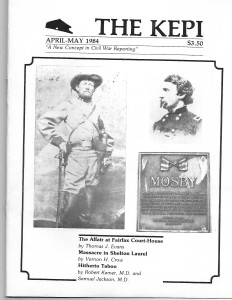The Kepi
A New Concept in Civil War Reporting


Non-Fiction Reference
Publishers and Editors-in-General
S.L. Kotar and J.E. Gessler
Available on AMAZON
AUTHOR’S NOTE
Putting together The Kepi Magazine
In speaking with devotees of the Civil War it has often struck me that those deeply immersed in studying the conflict, whether they refer to it as, “The War of Northern Aggression,” the “Blue and the Gray,” or the “War Between the States,” have a life-long fascination with it. When people ask me how and why I got interested, my answer is always the same: I was born to it. As early as I can remember, I was drawn to the Civil War. Nothing was too obscure or settled for me: I wanted to know everything about the battles and leaders, but more specifically I craved an understanding of the times, because to truly understand the past, you have to view it from the perspective of those who lived it.
Believing that others felt as I did, and that they weren’t satisfied with coffee table publications specializing in repeating the tried and the true without daring to reinterpret a battle or a strategy or even a personality, my partner and I decided we would publish a magazine dealing not only with fresh (and sometimes uncomfortable) views, but one that offered a more thorough examination of the mid-19th century. With an eye toward the iconoclastic, the odd and the unexplored, we began publishing in the time before personal computers were commonplace.
To present a professional magazine meant using a professional printer and typesetter. Starting out with grand ideas and a limited budget we quickly learned how to do a paste-up which is actually more complex than it sounds. We had to teach ourselves about various typefaces, column width and how to efficiently use space, where and how to insert illustrations and how to be judicious in the use of lines. The description “paste-up” comes from the fact that pages were literally pasted-up. After deciding how to arrange a page, the typesetting (which came on a long roll), was cut to size and blocked out on a piece of blue graph paper (the camera didn’t pick up the color blue). Then the back of the typesetting was covered with hot wax and placed on the graph paper, using the lines and squares to make the column even. When the wax dried, the page was “set” and ready to be “shot.”
As you read the issues from start to finish (the printer did the paste-up on the premiere issue and we did subsequent issues) I think you’ll see how we experimented with typefaces and lines, getting more and more adept as we went along. Ironically, this turned out to be the easiest part of the equation. What we anticipated would be the easiest actually turned out to be the most difficult: finding authors who were capable of writing about the War without falling into the trite and the rehashed. We didn’t want the same old story of Gettysburg, or a romanticized version of Stonewall in the Valley. We sought hard, gritty stories, or ones with new interpretations of cannon. And believe me, when you talk about the Civil War, there is most definitely “cannon.” And by that I mean, This is the way it is.
Perhaps there’s a comfort in the thought that you know a particular battle inside out. Perhaps that makes it easy to discuss when everyone is on the same page. But when you’re afraid to delve into probing questions, then you’re not an historian, you’re a fan. Fans were not our audience. That said, it proved extremely difficult to find articles worth publishing. We wanted to shake people out of their complacency but to do that we needed writers capable of producing thought-provoking material. We assumed they would beat a path to our door (we even paid a small fee) but they didn’t. Those articles we received might have been all right for a weekend reenactment, but it wasn’t interesting enough for us. So we ended up writing a number of articles ourselves, primarily on “Stonewall” Jackson, who happened to be our specialty. In re-reading these articles, as fresh to me now as when I wrote them decades ago, I hope you find some new insights and some thought-provoking interpretations. To add to our in-house staff we recruited several regular writers who had interests in medicine and religion. And I have to mention a gentleman who became a semi-regular writer for us, Thomas J. Evans. Although it’s been a long time since we communicated, Tom was a first rate investigator and we were honored to publish his material.
This is the background on The Kepi. After we ceased publishing we devoted our energies to fiction writing. We have quite a number of books in the R.B. Saga that I intend to publish in the near future that deal specifically with the War. Our trilogy, The Kansas Pirates, available on Amazon, is set pre-War and deals with a number of uncomfortable issues in “Bleeding Kansas.”
Thank you for visiting this site and good reading!
SLK
First Issue Volume I, Number 1
Cover: Statue at Fredericksburg, Virginia. Photo by J.E.Gessler.
Volume I, Number 2














